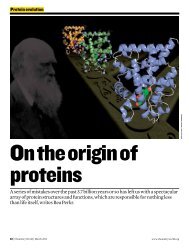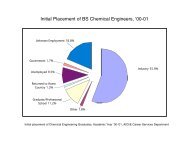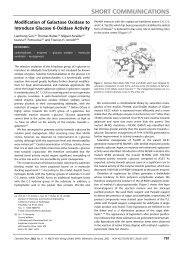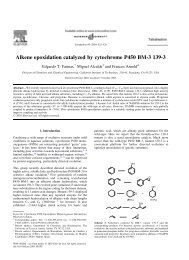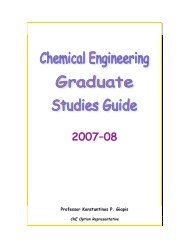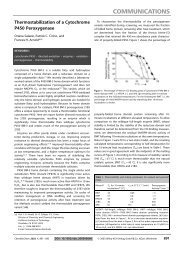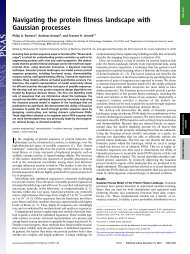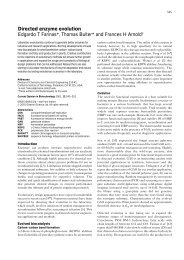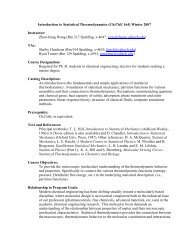Abhaya Datye - Department of Chemical Engineering
Abhaya Datye - Department of Chemical Engineering
Abhaya Datye - Department of Chemical Engineering
You also want an ePaper? Increase the reach of your titles
YUMPU automatically turns print PDFs into web optimized ePapers that Google loves.
Nanostructured Catalysts<strong>Abhaya</strong> K. <strong>Datye</strong>University <strong>of</strong> New Mexico
Issues• Control <strong>of</strong> surface composition• Facile synthesis via self assembly• Aggregation <strong>of</strong> nanoparticles
Control <strong>of</strong> Surface Compositionand Structure in Nanoparticles• Selective catalysts <strong>of</strong>ten involve more thanone element• Thermodynamics, preparation variables,<strong>of</strong>ten dictate the surface composition andstructure• How do we generate tailored surfacestructures
Restructuring <strong>of</strong> Pd-Ag CatalystsDuring Selective Hydrogenation<strong>of</strong> Trace Acetylene in EthyleneK. Lester, Y. Jin, H. Zea and A. K. <strong>Datye</strong>University <strong>of</strong> New Mexico, Center for Microengineered Materials and a<strong>Department</strong> <strong>of</strong> <strong>Chemical</strong> & Nuclear <strong>Engineering</strong>, Albuquerque, NM 87131,USAE. G. Rightor 1 , R. J. Gulotty 1 , J. J. Maj 1 , J. Blackson 1 , M. Holbrook 2 and C.Michael Smith 3 The Dow <strong>Chemical</strong> Company, 1 Midland, MI, 48674,2Plaquemine, LA 77565, 3 Freeport, TX 77541, , USA.Financial support provided by the U. S. DOE, Office<strong>of</strong> Basic Energy Sciences, grant DE-FG03-98ER14917 and by the Dow <strong>Chemical</strong> Company
Operating Conditions• Our reaction conditions correspond to the‘front end’ hydrogenation, where acetylene ispresent with a large excess <strong>of</strong> ethylene andalso an excess <strong>of</strong> hydrogen and some CO.• Feed:30% C 2 H 4 , 0.4% C 2 H 2 , 0.1% CO,16% H 2 and balance N 2 .
Hydrocarbon byproduct formation issuppressed on Pd-Ag after HTRSelectivity to Oligomers vs DeltaTemperature0.350.3Pd/Al 2O 3No pretreatmentSelectivity toOligomers0.250.20.150.1Pd+Ag/Al 2O 3500 C Pretreatment0.050-25 -20 -15 -10 -5 0 5 10 15 20 25Delta Temperature
High Temperature Reduction Causes a Drop inActivation Energy for Ethylene Hydrogenationon Bimetallic Pd-Ag catalystsC 2H 2 C 2H 4 C 2H 6Selectivity = moles ethylene producedmoles acetylene reacted0.5Pd-0.5Ag / SiO 2 Catalysts - Selectivity VsDelta Temperature.Arrhenius plot for 0.5 Pd - 0.5 Ag/SiO2catalystsEthylene Selectivity10.50-0.5-1-1.5-2-2.50 10 20 30 40Delta Temperature (oC)Reduced at 500 CReduced at 100 Cln(Ethene formed)-13-15-17-19Eactivation (kcal/mol) = 20.5 + 0.4Eactivation (kcal/mol) = 13.5 + 0.30.0024 0.0026 0.00281/T (1/K)Reduced at 500 C Reduced at 100 C∆T = reaction temperature – clean up temperatureClean up temperature is the temperature at which 99% <strong>of</strong> acetylene conversion isobtained
Ethylene Hydrogenation Is AStructure-InsensitiveReactionWhy should the activation energyfor ethylene hydrogenation beaffected by pretreatment?
Effect <strong>of</strong> CO adsorption onActivation Energy for EthyleneHydrogenationIf the surface is covered by CO, the activationenergy for ethylene reaction is simply theheat <strong>of</strong> desorption <strong>of</strong> COTherefore, changes in the heat <strong>of</strong> desorption<strong>of</strong> CO can change the activation energy forethylene hydrogenation
On Pd/SiO 2 , CO isadsorbed mainly in abridged modeThere is no effect <strong>of</strong>pretreatmentBridgeBridgeLinearLinearReduced at 70 CReduced at 400 C
On Pd-Ag/SiO2 , we see morelinearly bound CO thanbridged. High temperaturereduction further affects therelative concentrations <strong>of</strong> linearvs bridged COLinearBridgeLinearBridgeReduced at 70 CReduced at 400 C
Effect <strong>of</strong> Reduction TemperaturePd-Ag alloy, with some phasesegregationAg redistributes causing abreakup <strong>of</strong> the Pd ensemblesLow temperature reductionHigh Temperaturereduction
Pd/ SiO 2We see no effect <strong>of</strong> pretreatment onethylene hydrogenation activation energyPretreatmentActivation Energy as a function 100 C <strong>of</strong> Pretreatment500 CActivation Energy(Apparent) kcal/mol28 27The apparent activation energy for ethylene hydrogenation on Pdis consistent with the heat <strong>of</strong> adsorption <strong>of</strong> CO. From theliterature, the heat <strong>of</strong> adsorption for bridged CO ranges from 22-40kcal/mol depending on coverage.
Bridged CO is more stronglybound than linearly bonded COHeats <strong>of</strong> Adsortion <strong>of</strong> the Adsorbed CO Species on the VariousPd-Cointaining Solids at Low (E0) and High (E1) Coverage [1]Linear CO species Bridged CO SpeciesSample E0 (kcal/mol) E1(kcal/mol) E0 (kcal/mol) E1(kcal/mol)Pd (Cl-free)/Al2O3 22 13 40 22Pd (Cl)/Al2O3 22 13 40 18Pd (Cl-f)/CeO2/Al2O3 22 13 40 22Pd (Cl)/CeO2/Al2O3 22 13 40 16Pd (Cl)/La2O3/CeO2/Al2O3 22 13 40 25(Cl-f): Chlorine free solid(Cl): Chlorine containing solid[1] Dulaurent O, Chandes K, Bouly C and Bianchi D, Journal <strong>of</strong> Catalysis, v 192(#2), 2000
Arrhenius plot for Ethylene Hydrogenation on 0.5 Pd - 0.5Ag/SiO2 catalysts-13Eactivation (kcal/mol) = 20.5 + 0.4ln(Ethane formed)-15-17Eactivation (kcal/mol) = 13.5 + 0.3-190.0024 0.0026 0.00281/T (1/K)Reduced at 500 CReduced at 100 C
Schematic <strong>of</strong> RestructuringPhenomena in Pd-AgHigh Temperature ReductionHigh Temp OxidationPdOAgPd-Ag alloyEnrichment <strong>of</strong> Ag on Pd surfaceLow Temp OxidationPdAg 2O
Summary• High temperature pretreatments causerestructuring <strong>of</strong> Pd and Ag• Reducing the number <strong>of</strong> Pd nearestneighbors affects selectivity to oligomerformation• By modifying the adsorption <strong>of</strong> coadsorbedCO, we can control the activation energyfor ethylene hydrogenation and modify theselectivity for the reaction
Aerosol Synthesis <strong>of</strong> Nanostructured CatalystsMangesh Bore, Hien Pham, Timothy Ward,C. J. Brinker, <strong>Abhaya</strong> <strong>Datye</strong>Financial Support provided by NSF – NIRT, Centerfor Ceramic and Composite Materials and by theMaterials Corridor Council
Autoclave RouteReaction MixtureAutoclave150 o C48 hoursFiltrationCalcination• Liquid-Crystal Template Mechanism– Proposed by C. T. Kresge et al., Nature (1992)J. S. Beck et al., J. A. C. S. (1992)
MCM-41Irregular shapes
Aerosol RouteCalcination• Evaporation Induced Self Assembly (EISA)– Proposed by Jeffrey Brinker et. al., Nature (1999)– Evaporation <strong>of</strong> solvent leads to ordering <strong>of</strong> surfactantstructures– Condensation <strong>of</strong> silica follows the formation <strong>of</strong> templatedstructures to lock in the structure
Control <strong>of</strong> Particle StructureY. Lu, H. Fan, A. Stump, T.L. Ward, T. Rieker, C.J. Brinker,Nature 398 (1999) 223Hexagonal nanostructure:interconnected hexagonallypacked spherical pores,1200 m 2 /g, d=3.2 nm (5 wt%CTAB)cubic nanostructure:interconnected poresarranged in simple cubiclattice (4.2 wt% B56)lamellar “onion-skin”structure: concentricshells <strong>of</strong> silica separatedby pore volume, 478m 2 /g, d=9.2 nm (5wt%P123)
ComparisonAerosol Synthesis• Continuous process• Reaction time seconds• Spherical particles• 3-D interconnected porestructure (local order ishexagonal)Autoclave Synthesis• Batch process• Reaction time hours• Irregular shapes• Most common is the 2-Dstructure
TEMRegular shapesParticle consists <strong>of</strong> small ordered domains <strong>of</strong> pores
After Hydrothermal Stability Test at 750°C10% water vapor, 2 hoursSiO 2Si/Al 20Aluminum incorporation improves the hydrothermal stability <strong>of</strong> mesoporous silicaparticles.
Hydrothermal Stability Test (batch vs. aerosol route)10% water vapor, 2 hours16001400Si/Al molar ratio 20Surface Area (sq m/gm)12001000800600Batch Si-AlAerosol Si-Al400Davisil silica gelAerosol Silica2000Initial 500 550 600 650 700 750Temperature (C)Batch Silica
TEM/STEM images <strong>of</strong> Au/NH 2 -MCM-41The average Au nanoparticle diameter is small (~1 nm), andthe nanoparticles are dispersed inside the pores.3-aminopropyltrimethoxysilane is used as the amine source
TEM Images <strong>of</strong> Ordered Nanocrystal/Silica Nanostructures[100]Before calcinationA20 nmBCCourtesy <strong>of</strong> Hongyou Fan, Jeff BrinkerSandiaNationalLaboratories
Diffusion <strong>of</strong> Three-Dimensional Metal Particleson an Oxide Substrate: Implications for theSintering <strong>of</strong> Heterogeneous CatalystsLani Miyoshi Sanders<strong>Abhaya</strong> K. <strong>Datye</strong>Univ. <strong>of</strong> New Mexico, Albuquerque, NMBrian SwartzentruberSandia National Labs, Albuquerque, NM
Experimental Approach:Atom-Tracking ScanningTunneling Microscopy <strong>of</strong>Pd/TiO (110)2
Conventional STMEach image takes severalseconds, missing many rotationevents…time resolution 1000xSi-Ge Ad-Dimer onSi(001)Atom TrackingTipSTMDeveloped by Brian Swartzentruber, Sandia Labsygt1t2x
TiO 2 (110) Surface100x100Å 23Åx6.5ÅUnit cellFrom: M.J.J.Jak, Ph.D. Dissertation, Nov.2000.
DepositingPd300x300Å 2 300x300Å 2ast deposit @ 4 W, 2 sSlow deposit @ 3 W, 4 min
DiffusionCharacteristicsDiffusion isessentially confinedto the [001] directionPresence <strong>of</strong>small, mobileparticlesrapidlydecays due topinning andgrowthStepdecoration isprevalent onlyon stepsperpendicularto [001]400x600Å 2Diffusing particles hop discretely with length<strong>of</strong> underlying unit cell <strong>of</strong> substrate
Atom-Tracking <strong>of</strong> PdParticle Diffusion[001]Y (Angstrom)165160155150145140135130145 155X (Angstrom)165160155150145140135130100x100Å 20 10 20 30 40 50Time (s)
Scaling Analysis for Pd ParticleDiffusion1E-14Diffusion Coefficient (cm^2/s)1E-151E-161E-17n=0.86±0.09n=1.06±0.10n=1.07±0.1042°C36°C25°C1 10 100Particle Size (# <strong>of</strong> Atoms)
3-D D Monte Carlo model gives insights intodecreased motion <strong>of</strong> larger particlesdisordered surfaceshigh surface free energyhoppingd -1very small particlesshift indiffusionmechanismgrowshift inscaling lawlarger particlesperiphery diffusiond -7faceting300x300Å 2



